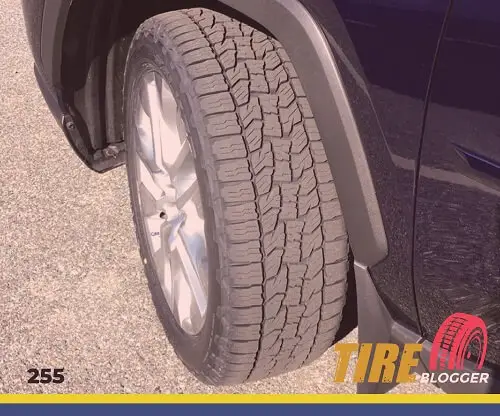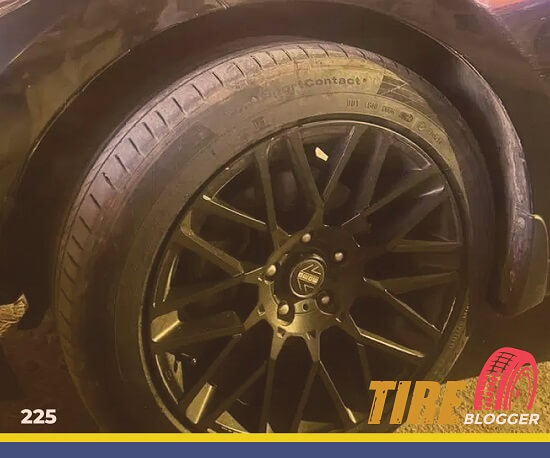225 vs 255 Tires

The section width is the main difference between 225 and 255 tires, with the latter being approximately 30 millimeters wider. This width difference can impact various performance factors.
225 vs 255 Table
| 255 Tires | 225 Tires |
|---|---|
| Slightly lower Gas Mileage due to increased rolling resistance and rotational mass. | Generally better fuel efficiency with a smaller contact patch and less rotational mass. |
| Generally offers a more comfortable ride with a wider contact patch and taller sidewall. | Maintains a responsive, agile feel but may be perceived as less comfortable compared to 255 tires. |
| Offers a more aggressive and muscular aesthetic appeal. | Contributes positively to vehicle aerodynamics with a narrower profile. |
| Provides improved stability and traction, especially in off-road scenarios. | Enhanced handling and quicker response on paved roads. |
| Approximately 15% greater load capacity due to a larger contact patch. | Lower load capacity compared to 255 tires. |
| May generate slightly more road noise but could dampen vibrations. | Provides a quieter ride on smooth surfaces but may transmit more vibrations. |
| Exhibits substantial durability with slightly faster tread wear. | Potentially more even wear and longer average tread life based on typical driving conditions. |
| Provides advantageous traction in specific off-road or muddy conditions. | Navigates snow and ice marginally more effectively due to less contact patch. |
Gas Mileage
With a slightly smaller contact patch and less rotational mass, 225 tires generally confer better fuel efficiency, an aspect crucial for daily commuters and long-distance travelers.
The larger 255 diameter and width might detract from fuel efficiency owing to increased rolling resistance and rotational mass. The heavier weight of 255 tires gives slightly less gas mileage.
Ride Comfort
The wider 255 tires generally offer a more comfortable ride than 225 tires due to their wider contact patch and taller sidewall.
The larger overall air volume cushions bump better. However, the narrower 225 maintains a responsive, agile feel that some drivers prefer over softness.

Aesthetics
The narrower 225 tires contribute positively to vehicle aerodynamics, whereas larger 255 tires can offer a more aggressive and muscular aesthetic appeal but may hinder aerodynamic efficiency slightly. Vehicle styling preferences vary.
Handling & Stability
The 225 smaller tires typically offer enhanced handling and quicker response on paved roads.
Conversely, the larger 255 tires provide improved stability and traction due to the larger contact patch, particularly in off-road scenarios or on uneven surfaces.
Load Capacity
The load capacity increases with the 255 tire width. This results from a larger contact patch, which can distribute the weight over a wider area. The 255 has approximately 15% greater load capacity than the 225 size.

Noise & Vibration
The narrower 225 tires may provide a quieter ride on smooth surfaces but might transmit more vibrations from road irregularities.
The larger 255 tires, especially those with aggressive treads, generate slightly more road noise but could also dampen vibrations due to greater air volume and sidewall height.
Durability & Wear
The 225 smaller tires exhibit potentially more even wear and longer average tread life based on typical driving conditions.
However, the larger 255 tires, while enduring more impacts and absorbing more stress, exhibit substantial durability with only slightly faster tread wear.
Adverse Conditions
The narrower 225 tires can sometimes navigate snow and ice marginally more effectively by cutting through to the road surface due to less contact patch.
However, the wider 255 tires provide advantageous traction in specific off-road or muddy conditions due to increased surface area.

How Much Taller Is a 255 Tire Than a 225?
The height difference between a 255 tire and a 225 tire depends on the aspect ratio of each tire. Assuming both tires share the same typical SUV/truck aspect ratio of 70, we can calculate the sidewall height of each tire as follows:
- The 255 tire has a size of 255 mm. With a 70 aspect ratio, the sidewall height works out to 255 x 0.70 = 178.5 mm.
- The 225 tire has a size of 225 mm. At that same 70 aspect ratio, its sidewall height is 225 x 0.70 = 157.5 mm.
Subtracting these sidewall heights shows the 255 tire sidewall sits 21 mm taller than the 225’s sidewall (178.5 – 157.5 = 21 mm).
And since tires have two sidewalls, one on top and one on the bottom, the total height difference between the full 255 tires and 225 tires is double that per-sidewall difference.
So, with identical 70 aspect ratios, the overall height of a 255 tire would be 42 mm more than a 225 tire (2 x 21 mm).
In summary, if fitted with typical truck/SUV aspect ratios, a 255 tire will always sit 42 mm taller than a 225 size tire of the same proportions. This assumes both share the same rim size – varying rims would also impact relative height.
How Much Wider Is A 255 Tire Than A 225?
The width of a tire is represented by its size marking imprinted on the sidewall. A 225 tire has a width of 225 millimeters, while a 255 tire has a width of 255 millimeters.
So a 255 width tire is 30 millimeters wider than a 225 width tire. This 30-millimeter difference may not seem substantial, but it can significantly affect handling, braking, and acceleration performance when replacing tires for trucks, SUVs, and performance vehicles.

How Tall Is A 225 Tire?
The height of a 225 tire size depends on the aspect ratio and rim size. Let’s make the same assumption that these tire sizes are in millimeters, have a typical SUV/truck aspect ratio of 70, and are mounted on a 17-inch wheel.
With these assumptions:
- The 225 tire width is 225 millimeters
- The aspect ratio is 70%
- So the sidewall height is 225 x 0.70 = 157.5 millimeters
- Since there are two sidewalls, the total sidewall height is 2 x 157.5 = 315 mm
- The total wheel diameter with a 17-inch rim is 17 inches = 431.8 mm
- So the overall tire height is the rim diameter + 2x the sidewall height = 431.8 mm + 315 mm = 746.8 mm = 29.42 inches
Therefore, assuming an aspect ratio of 70% and a 17-inch wheel rim size, the total height of a 225 tire is 29.42 inches.
Can I Use 255 Tires Instead Of 225?
It is crucial to ensure that the overall diameter of the replacement tire is within 3% of the original tire when changing tires. To calculate the overall diameter, consider the aspect ratio and rim size.
Let’s assume the original and replacement tires have the same aspect ratio of 70 and 17-inch rim size. For instance, the overall diameter of a 255 tire size is 31.06 inches, while that of a 225 tire size is 29.4 inches.
Since the overall diameter of the replacement tire exceeds the 3% limit, you cannot replace a 255 tire size with a 225 tire size. However, it’s important to note that this rule only applies to tires with the same aspect ratio and rim size.
Our Observation
The 225 tires are best suited to vehicles focused on fuel economy, handling performance, and quieter rides. These provide compelling advantages for daily drivers or sports sedans.
The 255 tires are optimized for load capacity, off-road stability, and ride comfort. Drivers of trucks, SUVs, and performance vehicles will benefit most from the 255 size.
Ultimately, we recommend narrower 225 tires for lighter vehicles where handling and fuel efficiency matter most. For larger vehicles driven in various conditions, we suggest wider 255 tires for their added traction and load capability.
However, the performance differences are minor, so personal vehicle use, priorities and needs should primarily determine selection.

Meet Caitlin McCormack, a Tire Size Expert and Blogger Passionate About Everything Related to Tires. With Years of Experience in the Tire Industry, Caitlin Has Become an Expert in Tire Sizes and Their Impact on Vehicle Performance.

Very insightful article. Thanks
Thank you for your kind words!